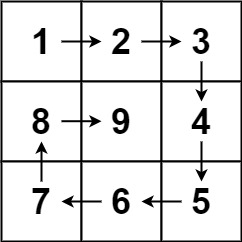Spiral Matrix II - Two approaches
Problem Statement:
Given a positive integer n, generate an n x n matrix filled with elements from 1 to n2 in spiral order.
Example 1:

Input: n = 3 Output: [[1,2,3],[8,9,4],[7,6,5]]
Example 2:
Input: n = 1 Output: [[1]]
Constraints:
1 <= n <= 20
Solution:
Approach1
This approach is based on using min, max for x and y carefully. Basically. You go in cycles of
Increment Y
Increement X
Decrement Y
Decrement X
The bounds also have to change so that we traverse the spiral.
class Solution {
public:
vector<vector<int>> generateMatrix(int n) {
vector<vector<int>> M(n, vector<int>(n,0));
int x=0, y=0, curr=1, x_min=0, x_max=n-1, y_min=0, y_max=n-1;
while (x>x_min||x<x_max||y>y_min||y<y_max)
{
while (y<y_max) M[x][y++]=curr++; x_min++;
while (x<x_max) M[x++][y]=curr++; y_max--;
while (y>y_min) M[x][y--]=curr++; x_max--;
while (x>x_min) M[x--][y]=curr++; y_min++;
}
M[x][y]=curr;
return M;
}
};
TC: O(n^2)
SC: O(1)
Verdict: Faster than 100% solutions Memory less than 90% solutions
Approach 2
This approach uses an observation:
For N=3 ie 9 elements, we see the pattern v=[3,2,2,1,1] (Total 9) ie 3 numbers from Left to Right => then 2 from Top to Bottom ==> then 2 from Right to Left ==> then 1 from Bottom to Top ==> then 1 from Left to Right.
Similarly for N=4 ie 16 elements, the pattern is v=[4,3,3,2,2,1,1].
Similarly for N=5 ie 25 elements we have v=[5,4,4,3,3,2,2,1,1]
class Solution {
public:
vector<vector<int>> generateMatrix(int n) {
vector<vector<int>> M(n, vector<int>(n,0));
vector<int>v;
for (int i=1;i<n;i++){v.push_back(i);v.push_back(i);} v.push_back(n-1);
reverse(v.begin(),v.end());
// 2,2,2,1,1
int curr=1;
int x=0,y=0;
for (int i=0; i<v.size(); i++)
{
for (int j=0; j<v[i]; j++)
{
M[x][y]=curr;
curr++;
if (i%4==0) y++;
if (i%4==1) x++;
if (i%4==2) y--;
if (i%4==3) x--;
}
}
M[x][y]=curr;
return M;
}
};
TC: O(n^2)
SC: O(n)
Verdict: Faster than 100% solutions Memory less than 30% solutions